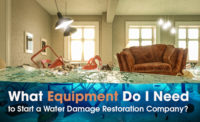Identify Your Company’s Pain Points and Start Solving Them With Tech

Photo credit: metamorworks/iStock/Getty Images Plus via Getty Images
It’s no secret that the tried-and-true is generally the preferred default for many restoration industry professionals. Maybe that’s because success is, in some ways, the enemy of innovation. After all, if it ain’t broke, don’t fix it, right?
Maybe it’s simple human nature. If the last year or so has taught us anything, it’s that people fear and resist change, especially when it’s change they didn’t ask for in the first place.
However, when existing technology offers a compelling, competitive advantage and a track record of excellent performance, it’s time to take a serious look at what that tech can offer you and your business.
Such is the case with the adoption of new tech to optimize claims estimating. According to R&R’s 2021 State of the Industry Report, technology adoption is one of the top challenges of restoration companies. This comes at a time when hiring and finding employees was also cited by almost two-thirds of respondents as a primary concern.
These two elements — the integration of tech and the need for more staff or greater productivity for existing staff — go hand-in-hand. There is the desire to speed up claim submission along with other elements of the process. There is already well-researched and dependable technology out there that can do this, and do it reliably.
However, there are two significant barriers to the integration of the technology that could provide game-changing solutions for the industry — cost and integration. These barriers are more perception than reality, however.
There is already a cost in terms of the software that is used by the industry. There is software required to input data, for sketching and for estimating the cost of damages. Adding another platform or program, then, isn’t very popular, resulting in hesitancy to invest financially in new technology.
While your trusty tape measure may last forever, tech is not meant to do so. That’s why it’s essential to continue investing in new technology and to consider tech as an ongoing cost of doing business. Unlike other expenditures, your tech can reasonably be expected to improve year after year with each update. As that tech improves, it offers new capabilities that make it well worth the price of purchase and implementation.
Another potential capability of tech is the creation of truly integrated systems and processes. As technology continues to progress, the costs associated with acquisition and implementation will be offset by the savings they provide.
For example, when you capture data manually, there’s both the capturing process (measuring, photography) and the input process of adding the data to the existing software. There’s a cost involved in both. Now add to that the cost associated with adding, onboarding, training and implementing a new technology. The perceived cost is too high for many business owners.
That is a short-sighted view, however. As it helps them speed up their claims, as it helps them speed up the process, as it helps them acquire and retain good clients, as it helps them do more with less, and, ultimately, as more integrated tech saves money on every transaction, restoration professionals will have to be more open-minded to incorporating new technologies.
There’s a cost involved in having people onsite to capture data. The amount of time they spend onsite, how many site visits occur, the transportation involved — those costs can be cut down through the use of technology.
When you’re capturing data with fancier, more robust, more comprehensive technology, you’re spending less time onsite and conducting fewer site visits, in theory. Why? Because you’ve captured more data than you would have if you were doing it manually. You don’t have to go back to the site if you missed something or need additional information.
That’s the driver, then, because although there is an initial cost, industry professionals will be cutting costs once the technology is integrated into their workflow. Once those businesses and those professionals are more efficient — both cost-efficient and time-efficient — that not only leads to greater productivity and more accuracy, it alleviates staffing concerns.
When you have more robust data capture, data collection and input are no longer separate processes — they’re a single process. When you’re able to do more, cut down on errors, transmit data in real time to the stakeholders, keep it on file and revisit it as needed, all of these things improve individual efficiency while cutting costs as much as 50% over time.
Right now, every claim involves a sketch. That means drawing the property out, indicating damages, checking for accuracy. The entire process depends on the quality of the measurements and the other data that is gathered. The way forward, then, is to improve the accuracy so that the sketching and estimating processes can also be improved. As technology makes that data better, the claims process is faster and more accurate.
I get it. People don’t like to change. However, the technology that is available today makes it unacceptable to use old-school methods. There’s a threshold beyond which a reluctance to grow and change is no longer a neutral choice or a matter of quirky personal preference. It’s irresponsible and, simply, bad business.Looking for a reprint of this article?
From high-res PDFs to custom plaques, order your copy today!








